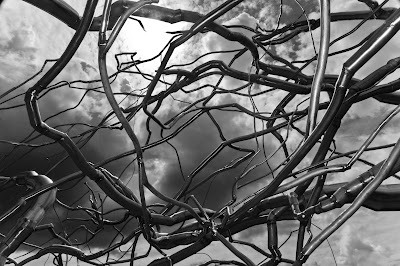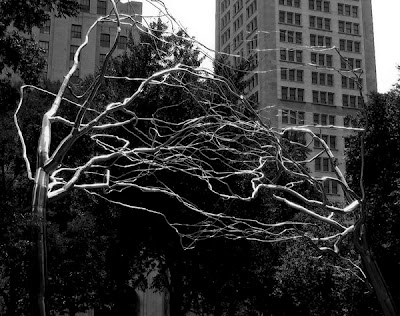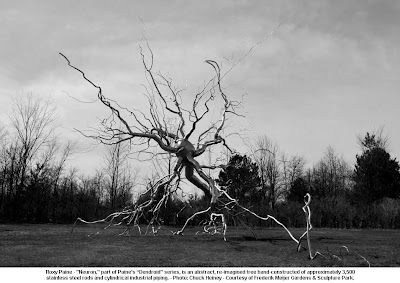 “It is not often that a contemporary sculpture in New York becomes a must-see attraction for city residents and visitors alike—a shining, touchable apparatus beloved by inquisitive children, and a visual marvel whose formal complexity appeals to adults. But that’s exactly what happened when Roxy Paine’s Maelstrom (2009) was temporarily installed last year on the rooftop of the Metropolitan Museum of Art. Measuring 29 by 130 by 45 feet, the work features stainless steel pipes, plates and rods that have been bent, dented and conjoined into branchlike structures resembling a forest savaged by a tornado or some other cataclysm. Paine cites as inspiration the 1908 Tunguska Event, in which, apparently, a meteor exploded in midair and walloped the Siberian forest below, toppling some 80 million trees. (UFO enthusiasts attribute this blast to an alien spaceship or weapon.) Everywhere in the wilderness, though, one finds evidence of convulsive transformations, and that’s what Paine evokes with Maelstrom: overwhelming force, endless cycles of growth and destruction. At the same time, the gleaming work—enchanting and serene—offered a meditative idyll overlooking Central Park.
“It is not often that a contemporary sculpture in New York becomes a must-see attraction for city residents and visitors alike—a shining, touchable apparatus beloved by inquisitive children, and a visual marvel whose formal complexity appeals to adults. But that’s exactly what happened when Roxy Paine’s Maelstrom (2009) was temporarily installed last year on the rooftop of the Metropolitan Museum of Art. Measuring 29 by 130 by 45 feet, the work features stainless steel pipes, plates and rods that have been bent, dented and conjoined into branchlike structures resembling a forest savaged by a tornado or some other cataclysm. Paine cites as inspiration the 1908 Tunguska Event, in which, apparently, a meteor exploded in midair and walloped the Siberian forest below, toppling some 80 million trees. (UFO enthusiasts attribute this blast to an alien spaceship or weapon.) Everywhere in the wilderness, though, one finds evidence of convulsive transformations, and that’s what Paine evokes with Maelstrom: overwhelming force, endless cycles of growth and destruction. At the same time, the gleaming work—enchanting and serene—offered a meditative idyll overlooking Central Park.“Several large branches and stout trunks touched the roof’s concrete surface and angled upward. Welds were clearly visible; industrial markings (numbers, product names and the like) were too. Paine’s nature simulacrum flaunts how concocted and fabricated it really is. At the Met, these forms, suggesting unbridled growth, sprouted into an aerial tangle of thin, elongated branches going every which way—reaching toward the sky, descending to the floor, probing the far borders of the roof like creeping tendrils, joining to form an overhead thicket or canopy. While in fact static, the work as a whole seems kinetic, suffused with swirling motion and circulating energy: an intricate, laboriously fashioned installation, charged with the rapidity and power of lightning bolts, whirlpools, cyclonic winds.
“At the time, Maelstrom is the largest and most ambitious of the outdoor sculptures Paine calls Dendroids, a term that refers to trees but also connotes anything else that involves branching systems, such as synaptic structures, computer board circuitry and fungal mycelium (connective tissue that allows a single organism to spread underground, sometimes across huge expanses). Such widely diverse references, common for Paine, are essential to Maelstrom. At a couple of points, Paine’s branchlike forms connected to what looked like functioning standpipes. Suddenly Maelstrom appeared as a crazy, bursting outgrowth of the building’s own plumbing, one of the largely hidden internal systems that—like gastrointestinal and cardiovascular systems servicing a body—enable the museum to function. Another possible reference is to the brain in extremis, with its neural network gone haywire, as in an epileptic seizure or a moment of extreme excitation or fear.”
Read the rest here



